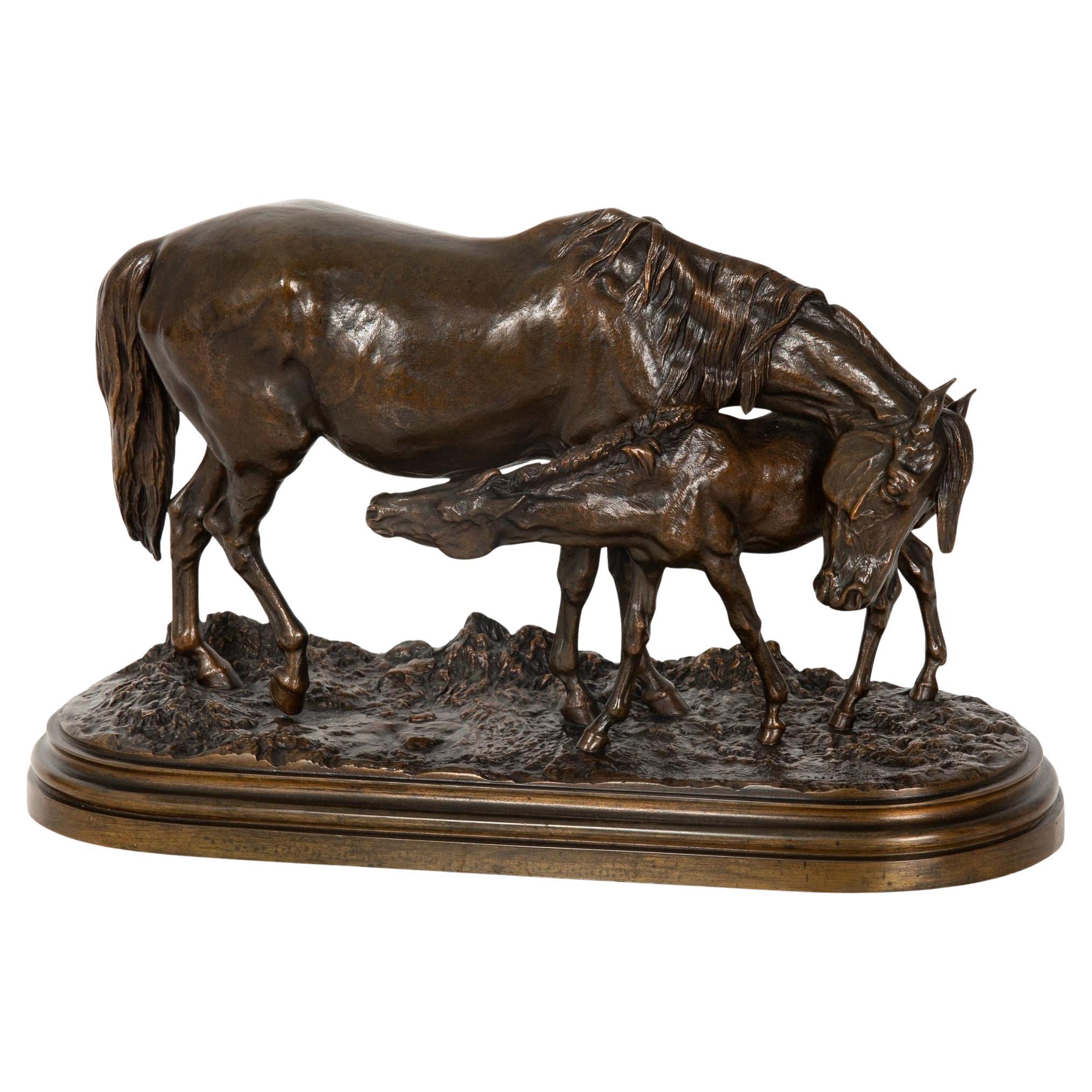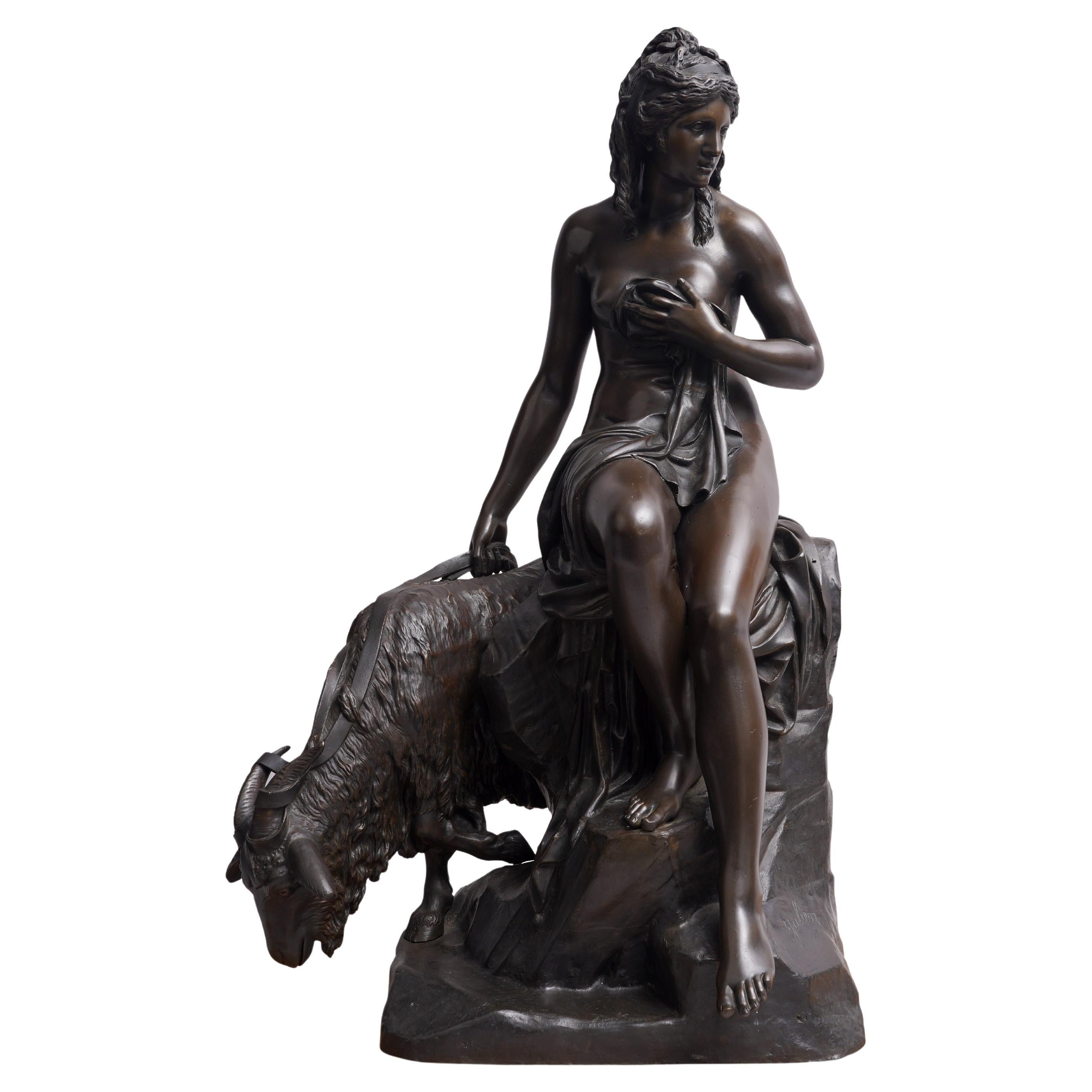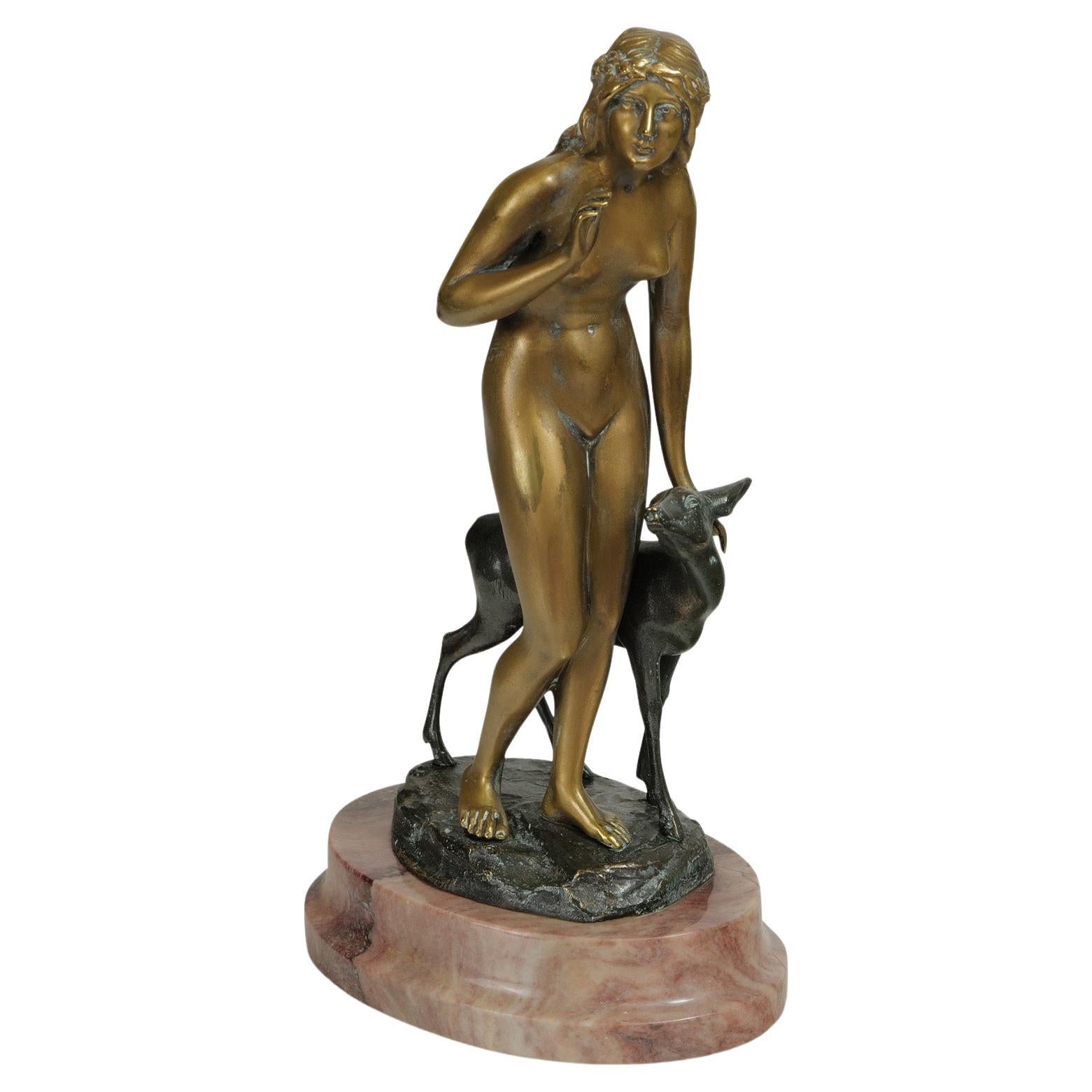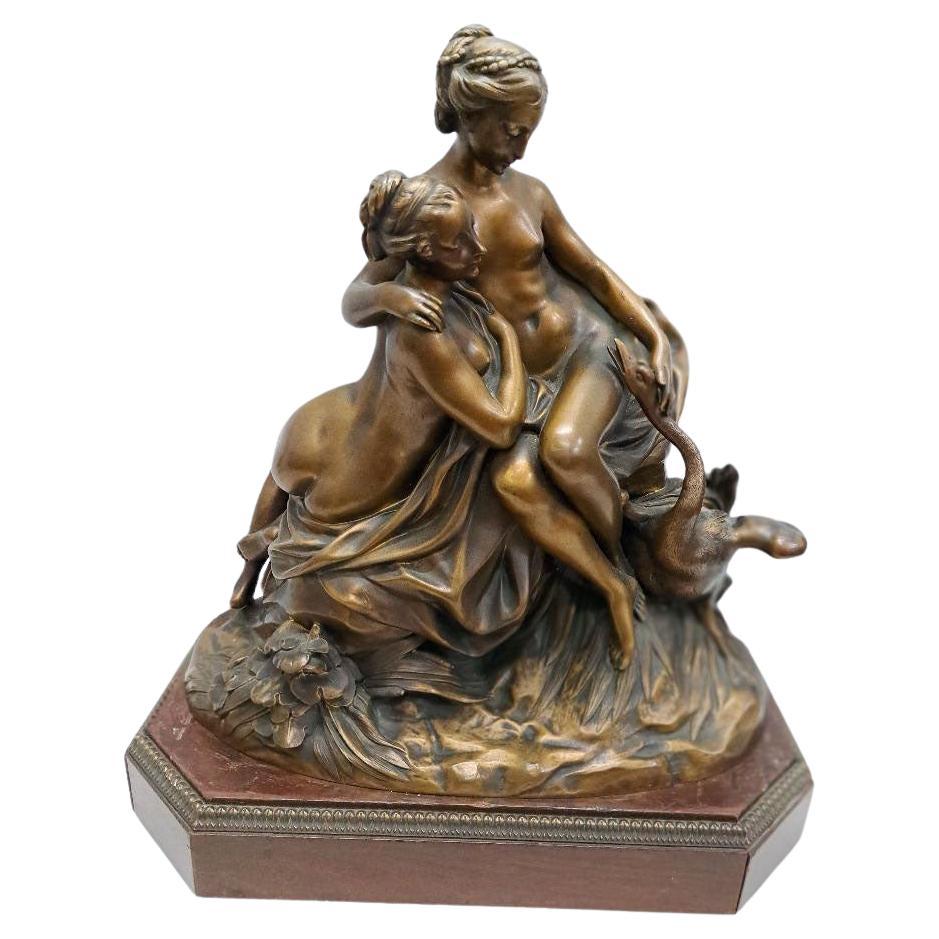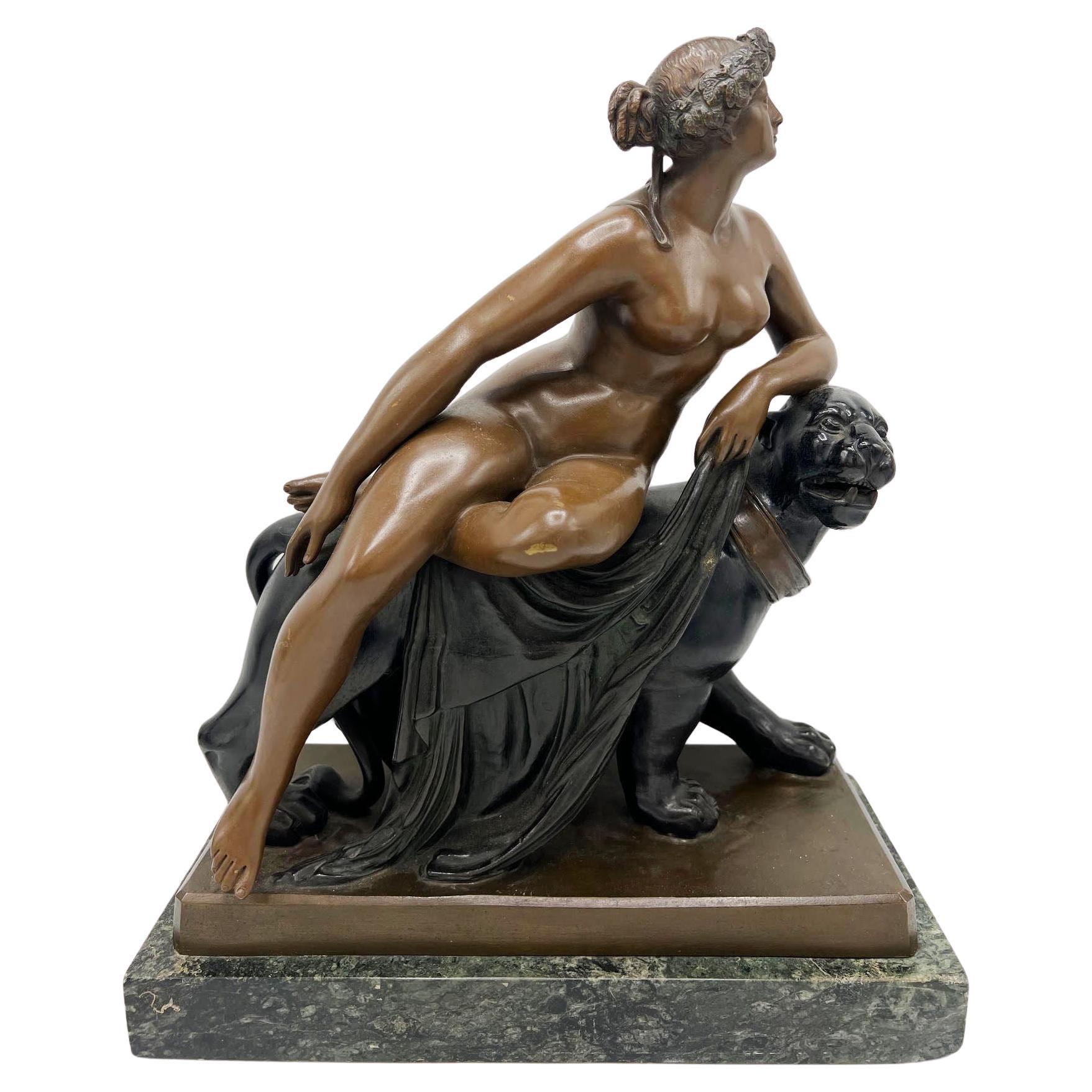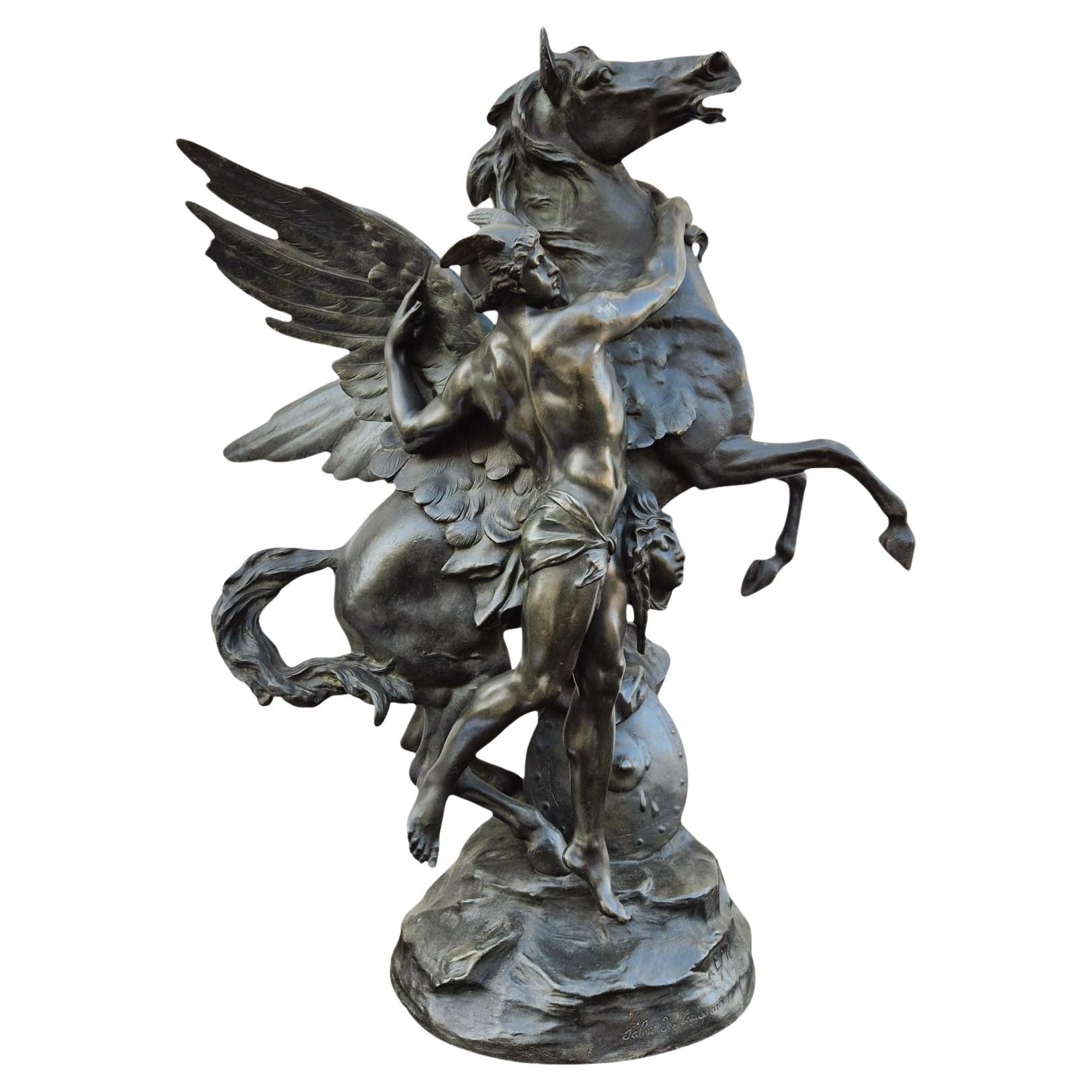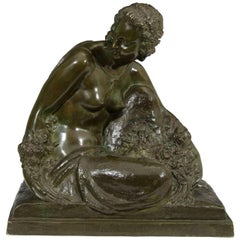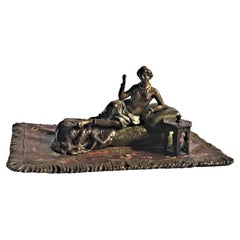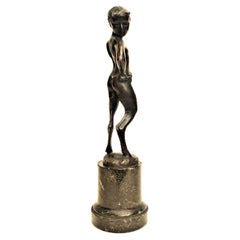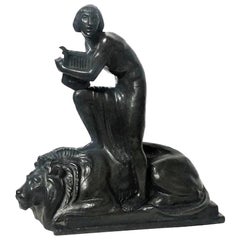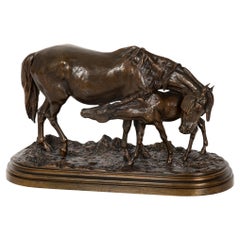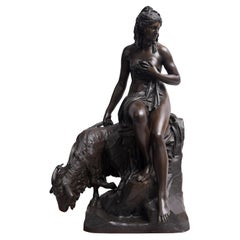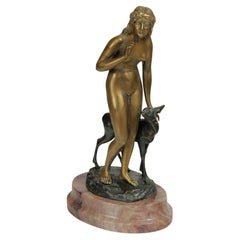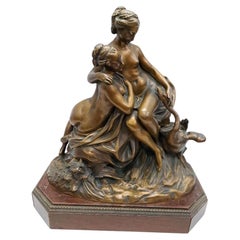Items Similar to Alexandre Henri Devaulx, Centaur Nursing her Baby, French Belle Epoque, c. 1880s
Want more images or videos?
Request additional images or videos from the seller
1 of 13
Alexandre Henri Devaulx, Centaur Nursing her Baby, French Belle Epoque, c. 1880s
$3,500
£2,643.47
€3,055.07
CA$4,909.29
A$5,459.60
CHF 2,857.85
MX$66,600.49
NOK 35,909.92
SEK 33,777.91
DKK 22,804.09
About the Item
Signed “A.H. Devaulx”, and marked “Susse Fes Ed.20”
Dimensions: Height 6-7/8”, width 7-7/8”, depth 4-1/4”
This wonderfully unusual desktop sculpture of gilded bronze, depicting a beautiful female-centaur breastfeeding her cub is made in a classic romantic style of the Belle Epoque era by a remarkable French sculptor, Alexandre Henri Devaulx.
Alexandre Henri Devaulx (French, 1856-1940) was the son of the noted sculptor of the Romanticism period, François Théodore Devaulx (1808–1870). Born in Paris, he studied under E. Devaulx, making his début as a sculptor at the 1876 Paris Salon with Portrait, a plaster medallion. Alexandre Henri Devaulx became a member of the Artistes Français in 1888, winning an award with merit in the same year....
Susse Frères Bronze Foundry, Paris - The French firm Susse Frères manufactured a daguerreotype camera, which was one of the first two photographic cameras ever sold to the public. The Susse Frères firm was also engaged in the foundry business and owned a large foundry in Paris. The company is well-known for their fine bronze castings with superbly applied patinas.
- Creator:Alexandre Henri Devaulx (Sculptor)
- Dimensions:Height: 6.88 in (17.48 cm)Width: 7.88 in (20.02 cm)Depth: 4.25 in (10.8 cm)
- Style:Belle Époque (Of the Period)
- Materials and Techniques:
- Place of Origin:
- Period:
- Date of Manufacture:1880s
- Condition:Wear consistent with age and use. We make our best effort to provide a fair and descriptive condition report. Please examine the photos attentively. Send us a message to request more details or discuss price.
- Seller Location:New York, NY
- Reference Number:1stDibs: LU2819317832231
About the Seller
5.0
Gold Seller
Premium sellers maintaining a 4.3+ rating and 24-hour response times
Established in 1993
1stDibs seller since 2017
84 sales on 1stDibs
Typical response time: 8 hours
- ShippingRetrieving quote...Shipping from: New York, NY
- Return Policy
Authenticity Guarantee
In the unlikely event there’s an issue with an item’s authenticity, contact us within 1 year for a full refund. DetailsMoney-Back Guarantee
If your item is not as described, is damaged in transit, or does not arrive, contact us within 7 days for a full refund. Details24-Hour Cancellation
You have a 24-hour grace period in which to reconsider your purchase, with no questions asked.Vetted Professional Sellers
Our world-class sellers must adhere to strict standards for service and quality, maintaining the integrity of our listings.Price-Match Guarantee
If you find that a seller listed the same item for a lower price elsewhere, we’ll match it.Trusted Global Delivery
Our best-in-class carrier network provides specialized shipping options worldwide, including custom delivery.More From This Seller
View AllMarcel-André Bouraine, Nude, French Art Deco Bronze Sculpture, circa 1920s
By Marcel-André Bouraine
Located in New York, NY
An Art Deco bronze sculpture of a seated semi-nude woman by Marcel-André Bouraine, French, 1886-1948.
Category
Vintage 1920s French Art Deco Figurative Sculptures
Materials
Bronze
$4,550 Sale Price
30% Off
Franz Xaver Bergmann, Odalisque, Vienna Bronze Sculpture, Ca. 1900
By Franz Xaver Bergman (Bergmann)
Located in New York, NY
This wonderful life-like sculpture depicts a half-naked odalisque reclining in a lazy pose on silk pillows on an ottoman, covered with a lion's skin. With bare breasts, only a small ...
Category
Antique 1890s Austrian Art Nouveau Figurative Sculptures
Materials
Bronze
Austrian Jugenstil Patinated Bronze Sculpture of Fawn Youth, Ca. 1900
Located in New York, NY
Probably Austrian, this lovely Jugenstil desk-sized black-patinated bronze figurine on its original marble pedestal depicts a fawn youth, checking the size of his tail to see how muc...
Category
Antique Early 1900s Austrian Jugendstil Figurative Sculptures
Materials
Marble, Bronze
Ernst Seger, David and Lion, German Art Deco Patinated Bronze Sculpture, c. 1920
By Ernst Seger
Located in New York, NY
Signed “E. Seger”.
Black patina.
Dimensions
Height: 8 inches (20cm)
Width: 7.5 inches (18.75cm)
Depth: 8.5 inches (21.25cm)
THE BIBLE STORY
Samuel 17:34-36
Originally, Saul would not allow David to fight Goliath (17:33). Saul’s reason was simply that Goliath would be stronger than David. David was young and he did not have the experience to fight such a capable enemy as Goliath. David was likely to die, and his death would benefit nobody.
Often people wrongly imagine that they are acting in faith (in other words, that they are trusting God). Really, they are acting in a foolish manner, as if the danger is not real. They are not trusting in God, but in their own thoughts, hopes and desires.
David’s reply to Saul shows us his attitudes. This reply explains clearly why David had offered to fight Goliath. In other words, it shows how David considered himself able to defeat Goliath.
Like many boys and young men in Israel, David had worked as a shepherd. That is, he looked after sheep. He was responsible to look after those sheep in every way. In particular, he had to protect them from wild animals.
Lions and bears are some of the fiercest large wild animals. They were common in Israel at the time of the Bible. They are much stronger than a man (see for example 1 Kings 13:24 and 2 Kings 2:24). Only the bravest and strongest men were able to kill a lion (Judges 14:5-6; 2 Samuel 23:20). However, David had killed both a lion and a bear. He had killed animals that were stronger than him.
David did not believe that the strongest man would win the fight. David had a close relationship with God; he was trusting God to rescue him (17:37). David was not pretending that there was no danger. However, God’s Holy Spirit was active in David’s life (16:13). By the power of his Holy Spirit, God had given David the faith (trust in God) to fight Goliath. Because David really was trusting God, there was no reason for him to be afraid of Goliath.
THE ARTIST
Ernst Seger (1865 1939), born in Neurode (Nowa Ruda, now Poland), studied sculpturing from 1884 at the Kunstschule in Breslau under Robert Härtel. From 1886 he worked in the Atelier of Christian Behrens, where he created the Eichendorff-Memorial for the Silezian City of Neisse. From 1893 to 1894 Seger stayed in Paris where he worked in the atelier of Auguste Rodin. However, Seger finally chose a ‘Jugenstill’ and a more ‘naturalistic’ or ‘Neuklassizismus’ style. His sculptures, modelled like the Greek antiques, were later greatly admired by the National Socialists.
At the end of 1894 Ernst Seger went back to Berlin, founded his own atelier and created the Kaiser Wilhelm I memorial for the Silesian City of Glatz. In 1897 Seger created the sculpture ‘Jugend’ (‘Youth’), which was displayed at the ‘Große Berliner Kunstausstellung’ in 1898, at the ‘Große Berliner Kunstausstellung’ in 1899, at the ‘Münchener Glaspalast Ausstellung’ in 1899 and at the ‘Münchener Glaspalast Ausstellung’ in 1908. As a sculptor Seger regarded this as his first relevant work, his breakthrough. A copy of the sculpture in bronze, 1.60 metres high, was placed in the ‘Scheitniger Park’ in Breslau (now Wroclaw). In 1898 Segers ‘Diana’, the Roman Goddess of the Hunt, the Moon and Childbirth, was unvealed in Park Szczytnicki, Breslau, Polen (earlier ‘Schneitniger Park’). Until 1945 the sculpture stayed in the Schneitniger Park, Breslau. This part of the park is still called ’Dianagarten’.
After the turn of the century the elegant female dancers and nudes by Seger gained great popularity. In 1905 Ernst Seger created -together with the sculptor Bernhard Sehring- the ‘Bismarck Brunnen’ (‘Bismarck Fountain’) in Breslau. This memorial-fountain (which still exists) represents the allegories ‘Kampf’ and ‘Sieg’ (‘Battle and Victory’). Seger’s ‘Verwundete Amazone’ (‘Wounded Amazon’), displayed at the Grosse Münchner Kunstausstellung in the Glaspalast in 1908, was placed in the garden of the ‘Kaufhauses Wertheim’ in Berlin. In the same year he was appointed as a professor. Seger’s marble sculpture ‘Kypris’, created in 1916, was placed in the Alten Nationalgalerie in Berlin. In 1925 the City of Berlin acquired his sculpture ‘Anbetung’ and placed it at the Johannaplatz. ‘Storchenbrunnen’ (‘Stork-fountain’), was placed in 1931 at the Adolf-Scheidt-Platz in Berlin. In 1935 the American newspaper publisher William Randolph Hearst bought Seger’s sleeping ‘Ganymede’.
During the Third Reich Ernst Seger was commissioned numerous Hitler busts...
Category
Vintage 1920s German Art Deco Figurative Sculptures
Materials
Bronze
Bernhard Johannes Karl Butzke, Fawn, Jugenstil Bronze Sculpture, ca. 1930
By Bernhard Johannes Karl Butzke
Located in New York, NY
MARKINGS & DETAILS Signed ‘B. Butzke’ on integral base. Original black veined marble plinth.
DIMENSIONS Height: 24 inches
Width: 15.5 inches
Depth: 9 inches
Base height: 1.5 i...
Category
Vintage 1930s German Art Deco Animal Sculptures
Materials
Bronze
French Belle Époque, Patinated Bronze Desktop Sculptural Paperweight, 19 Century
Located in New York, NY
Signed illegibly original red marble base.
Dimensions: H: 8.25” x W: 3.25” x D: 4.25” Base diameter: 2.75”
This beautiful and delicate desktop dark chocolate-brown patinated br...
Category
Antique 1870s French Belle Époque Paperweights
Materials
Marble, Bronze
You May Also Like
Rare French Antique Bronze Sculpture “Mare and Foal” by Isidore Bonheur
By Isidore Jules Bonheur
Located in Shippensburg, PA
ISIDORE JULES BONHEUR
French, 1827-1901
"Mare and her Foal"
Sand-cast nuanced medium-brown patinated bronze
Signed in cast "I. BONHEUR" and cold-stamped PEYROL verso
Cast circa 187...
Category
Antique 19th Century French Romantic Animal Sculptures
Materials
Bronze
A Large French Bronze Sculpture "Amalthea & Jupiter's Goat" after Pierre Julien
Located in Los Angeles, CA
A large 19th century patinated bronze group titled: "Amalthea and Jupiter's Goat" after Pierre Julien (French 1731-1804)
The goddess portrayed as nude but for drapery held across her breasts and falling to her lap, seated on the back of the goat with her right foot raised to rest on a rock outcrop.
Signed: Julien
Circa 1880.
Height: 34" (86.3 cm)
Width: 21" (53.3 cm)
Depth: 15" (38.1 cm)
Pierre Julien's model of Amalthée et la chèvre...
Category
Antique Late 19th Century French Louis XIV Figurative Sculptures
Materials
Bronze
Erich Schmidt-Kestner Bronze Girl with Deer on oval Marble Base circa 1910
Located in Münster, DE
Erich Schmidt-Kestner (1877 Berlin - 1941 Kassel)
Bronze “Girl with deer”
oval marble base, height 26 cm
German sculptor, studied at the art academies in Berlin and Düsseldorf, pa...
Category
Vintage 1910s German Belle Époque Figurative Sculptures
Materials
Marble, Bronze
Bronze Sculpture "Leda & The Swan" Wood Base, Etienne Maurice Falconet
By Étienne Maurice Falconet
Located in Autonomous City Buenos Aires, CABA
Falconet was born to a poor family in Paris. He was at first apprenticed to a marble-cutter, but some of his clay and wood figures, with the making of which he occupied his leisure h...
Category
20th Century French Belle Époque Figurative Sculptures
Materials
Bronze
Bronze Sculpture "Ariadne" Model by Johann Heinrich von Dannecker
By Johann Heinrich von Dannecker 1
Located in Autonomous City Buenos Aires, CABA
Bronze sculpture model "Ariadne" by Johann Heinrich von Dannecker
Beautiful sculpture that shows the goddess of hunting half-naked on a panther, in patinated bronze with a marble bas...
Category
Antique 19th Century German Belle Époque Figurative Sculptures
Materials
Marble, Bronze
E Picault, Perseus Or The Birth Of Pegasus, Signed Sculpture, Late 19th Century
By Émile Louis Picault
Located in MARSEILLE, FR
Perseus or the Birth of Pegasus: large group in patinated regular representing Perseus and the winged horse Pegasus
Large sculpture signed E Picault and bearing the mention 'Salon d...
Category
Antique Late 19th Century French Other Figurative Sculptures
Materials
Spelter
More Ways To Browse
1880s Bronze Sculptures
Bronze Baby
Susse Freres Bronze
Antique Centaur
Centaur Sculpture
Centaur Bronze
Plaster Medallion
Plaster Figure
Antique French Metal Signs
European Bronze Age
The Servant
Wooden Statues
Italian Sculpture 1930
Grand Tour Marble
Foot Sculpture Bronze
Wax Head
Bronze Sculpture Girl
Antique Headdress
